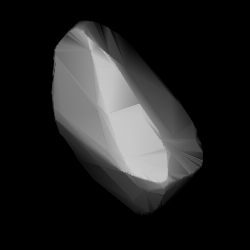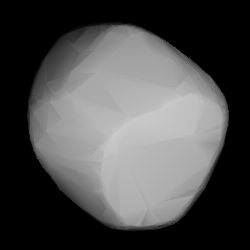2023 Asaph, provisional designation 1952 SA, is a dark asteroid from the outer regions of the asteroid belt, approximately 21 kilometers in diameter. It was discovered on 16 September 1952, by astronomers of the Indiana Asteroid Program at Goethe Link Observatory in Indiana, United States.

1032 Pafuri, provisional designation 1924 SA, is a dark background asteroid from the outer regions of the asteroid belt, approximately 65 kilometers in diameter. It was discovered on 30 May 1924, by English astronomer Harry Edwin Wood at the Union Observatory in Johannesburg, South Africa. The asteroid was named for the river in the Pafuri Triangle in South Africa, created by the confluence of the Limpopo and Levubu rivers. The body's spectral type and rotation period are still poorly determined.
1033 Simona, provisional designation 1924 SM, is a stony Eoan asteroid from the outer regions of the asteroid belt, approximately 20 kilometers in diameter. The asteroid was discovered by George Van Biesbroeck in 1924, who named it after his daughter Simona.
1049 Gotho, provisional designation 1925 RB, is a carbonaceous asteroid from the outer region of the asteroid belt, approximately 53 kilometers in diameter. It was discovered on 14 September 1925, by German astronomer Karl Reinmuth at Heidelberg Observatory in southwest Germany. Although the name of the asteroid is a masculine German name, it is not known to refer to a particular individual.

1119 Euboea is a background asteroid from the central region of the asteroid belt. It was discovered on 27 October 1927, by German astronomer Karl Reinmuth at the Heidelberg-Königstuhl State Observatory in southwest Germany. The asteroid has a rotation period of 11.4 hours and measures approximately 30 kilometers in diameter. It was named for the Greek island of Euboea.
1123 Shapleya, provisional designation 1928 ST, is a stony Florian asteroid from the inner regions of the asteroid belt, approximately 11 kilometers in diameter. It was discovered on 21 September 1928, by Russian astronomer Grigory Neujmin at Simeiz Observatory on the Crimean peninsula. It was named after American astronomer Harlow Shapley.

1244 Deira is a dark background asteroid and slow rotator from the inner region of the asteroid belt. The X-type asteroid has an exceptionally long rotation period of 210.6 hours and measures approximately 31 kilometers in diameter. It was discovered on 25 May 1932, by English-born South African astronomer Cyril Jackson at the Union Observatory in Johannesburg, who named it after Deira, an old kingdom near his birthplace, the market town of Ossett, located in West Yorkshire, England.

1555 Dejan, provisional designation 1941 SA, is an asteroid from the background population of the central regions of the asteroid belt, approximately 22 kilometers in diameter. It was discovered on 15 September 1941, by Belgian astronomer Fernand Rigaux at the Royal Observatory of Belgium in Uccle. The asteroid was named after Dejan Đurković, son of Serbian astronomer Petar Đurković.
1806 Derice, provisional designation 1971 LC, is a stony Flora asteroid from the inner regions of the asteroid belt, approximately 10 kilometers in diameter. Discovered on 13 June 1971, at the Bickley site of the Perth Observatory in Western Australia, it was the first discovery of a minor planet ever made in Oceania. The asteroid was named after the wife of Dennis Harwood, staff member at Bickley.
2126 Gerasimovich, provisional designation 1970 QZ, is a stony background asteroid from the inner regions of the asteroid belt, approximately 8 kilometers in diameter. It was discovered on 30 August 1970, by Soviet astronomer Tamara Smirnova at the Crimean Astrophysical Observatory in Nauchnyj, on the Crimean peninsula. The asteroid was named after Russian astronomer Boris Gerasimovich.

1836 Komarov is a carbonaceous Dorian asteroid from the central region of the asteroid belt, approximately 22 kilometers in diameter. It was discovered on 26 July 1971 by Russian astronomer Nikolai Chernykh at Crimean Astrophysical Observatory in Nauchnij on the Crimean peninsula. It was named after Soviet cosmonaut Vladimir Komarov.
4944 Kozlovskij, provisional designation 1987 RP3, is a carbonaceous Witt asteroid from the central regions of the asteroid belt, approximately 10 kilometers (6 miles) in diameter. It was discovered on 2 September 1987, by Soviet astronomer Lyudmila Chernykh at the Crimean Astrophysical Observatory in Nauchnij, on the Crimean Peninsula. The asteroid was named for Russian opera singer Ivan Kozlovsky.
2173 Maresjev, provisional designation 1974 QG1, is a dark background asteroid from the outer regions of the asteroid belt, approximately 28 kilometers (17 miles) in diameter. It was discovered on 22 August 1974, by Soviet–Ukrainian astronomer Lyudmila Zhuravleva at the Crimean Astrophysical Observatory in Nauchnij, on the Crimean peninsula. It was named for Soviet war veteran Alexey Maresyev. The assumed C-type asteroid has a tentative rotation period of 11.6 hours.
1303 Luthera, provisional designation 1928 FP, is a dark asteroid and the parent body of the Luthera family, located in the outermost regions of the asteroid belt. It measures approximately 90 kilometers in diameter. The asteroid was discovered on 16 March 1928, by astronomer Friedrich Schwassmann at the Bergedorf Observatory in Hamburg, Germany, and later named after German astronomer Robert Luther.
3406 Omsk, provisional designation 1969 DA, is a background asteroid from the central regions of the asteroid belt, approximately 15 kilometers in diameter. It was discovered on 21 February 1969, by Soviet astronomer Bella Burnasheva at the Crimean Astrophysical Observatory on the Crimean peninsula in Nauchnij. The possibly metallic M/X-type asteroid has a rotation period of 7.3 hours. It was named for the Russia city of Omsk.

1444 Pannonia is a carbonaceous background asteroid from the outer region of the asteroid belt, approximately 29 kilometers in diameter. It was discovered on 6 January 1938, by Hungarian astronomer György Kulin at Konkoly Observatory in Budapest, Hungary. It was named after the ancient province of the Roman Empire, Pannonia.
2478 Tokai, provisionally designated 1981 JC, is a stony Florian asteroid and binary system from the inner regions of the asteroid belt, approximately 10 kilometers in diameter. It was discovered on 4 May 1981, by Japanese astronomer Toshimasa Furuta at Tōkai Observatory, Japan. The asteroid was named after the city of Tōkai.

2120 Tyumenia is a dark background asteroid, approximately 45 kilometers in diameter, located in the outer regions of the asteroid belt. It was discovered on 9 September 1967, by Soviet astronomer Tamara Smirnova at the Crimean Astrophysical Observatory in Nauchnyj, on the Crimean peninsula. The asteroid was named for the now Russian district of Tyumen Oblast in Western Siberia.
3628 Božněmcová, provisional designation 1979 WD, is a rare-type asteroid from the middle region of the asteroid belt, approximately 7 kilometers in diameter. It was discovered on 25 November 1979, by Czech astronomer Zdeňka Vávrová at Kleť Observatory in the Czech Republic. It is named for Czech writer Božena Němcová.
7526 Ohtsuka, provisional designation 1993 AA, is a stony asteroid from the inner regions of the asteroid belt, approximately 7 kilometers in diameter. It was discovered by Japanese astronomer Takeshi Urata at Nihondaira Observatory Oohira Station, Japan, on 2 January 1993. The asteroid was named after Japanese astronomer Katsuhito Ohtsuka.







